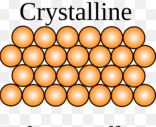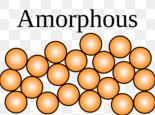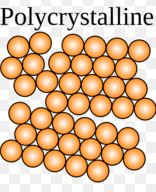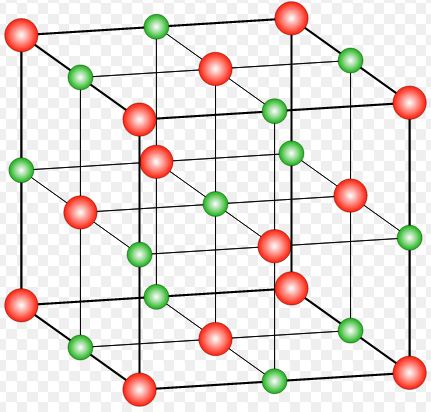Different Types of solid with Examples
Material has specifically used depending upon their characteristics and properties, such as hardness, ductility, malleability, conducting or magnetic, etc. What makes steel hard, lead soft, iron magnetic, and copper electrically conducting? It depends upon the structure- the particular order and bonding of atoms in a material. this clue has made it possible to design and create materials with new and unusual properties and uses for modern technology.
Types of Solid

Basically solids are classified into two types.
- Crystalline solids in which the arrangement of molecules is in a regular pattern such as gold, silver, diamond, graphite, sodium chloride, water, sugar, and iodine, etc.
- Amorphous solids in which the arrangement of molecules is not in a regular pattern such as plastic and glass.
Now!
We discuss in detail the classification of solids.
Crystalline Solids Definition
In crystalline solids, there is a regular arrangement of molecules. The neighbors of every molecule are arranged in a regular pattern that is constant throughout the crystal. There is, thus an ordered structure in crystalline solids.
The vast majority of solids, e.g., metals such as copper, iron, and zinc, ionic compounds such as sodium chloride ceramics such as zirconia are crystalline. The arrangement of molecules, atoms, or ions within all types of crystalline solids can be studied using various X-ray techniques. should be noted that atoms, molecules, or ions in a crystalline solid are not static. For example, each atom in a metal crystal vibrates about a fixed point with an amplitude that increases with a rise in temperature. it is the average atomic position which is perfectly ordered over large distances.
The cohesive forces between atoms molecules or ions crystalline solids maintain the strict long-range order in spite temperature at which the vibration becomes so greater than the structure suddenly breaks up, and the solid melts. The transition from solid (order) to liquid (disorder) is, therefore abrupt or discontinuous. Every crystalline solid has a definite melting point.
See Also: Stress Vs Strain
Amorphous solids definition
The word amorphous means without form or structure. Thus in amorphous solids, there is no regular arrangement of molecules like that bin crystalline solids. We can, therefore, say that amorphous solids are more like liquid with the disordered structure frozen in.
For example, ordinary glass, which is a solid at ordinary temperature, has no regular arrangement of molecules. On heating, it gradually softens into a paste-like state before it becomes a very viscous liquid at almost 800°c. Thus amorphous solids are also called glassy solids. This type of solids has no definite melting point.
Polymeric Solids
Polymers may be said to be more or less solid materials with a structure that is intermediate between order and disorder. They can be classified as partially or poorly crystalline solids.
Polymers from a large group of naturally occurring and synthetic materials. Plastic and synthetic rubbers are termed ‘Polymers’ because they are formed by polymerization reactions in which relatively simple molecules are chemically combined into massive long-chain molecules or “three-dimensional” structures. This material has rather low specific gravity compared with even the lightest of metals, and yet exhibit strength-to-weight ratio.
Polymers consist wholly or in part of chemical combinations of carbon with oxygen, hydrogen, nitrogen, and other metallic or non-metallic elements. Polythene, polystyrene, and nylon,etc., are examples of polymers. Natural rubber is composed in the pure state entirely of a hydrocarbon with the formula (C5H6).
Crystal Lattice
A crystalline solid consists of a three-dimensional pattern that repeats itself over and over again. The smallest three-dimensional basic structure is called a unit cell. The whole structure obtained by the repetition of the unit cell is known as crystal lattice. For example, the pattern of Na Cl particles has a cube shape. The cube shape of the sodium chloride is just one of several crystal shapes. In a cubic crystal, all the sides meet at right angles. Other crystal shapes have corners in which one or more of the angles are not right angles.
Mechanical Properties of solids
Deformation in solids
If we hold a soft rubber ball in our hand and then squeeze it, the shape or volume of the ball will change. However, if we stop squeezing the ball, and open our hand, the ball will return to its original spherical shape. This has been illustrated schematically.
Similarly, if we hold two ends of rubber strings in our hands, and move our hands apart to some extent, the length of the string will increase under the action of the applied force exerted by our hands. Greater the applied force larger will be the increase in length. Now on removing the applied force, the string will return to its original length. From this example, it is concluded that deformation (i.e., change in shape length or volume) is produced when a body is subjected to some external force.
In crystalline solids, atoms are usually arranged in a certain order. these atoms are held about their equilibrium position, which depends on the strength of the inter-atomic cohesive force between them. When an external force is applied to such a body, distortion results because of the displacement of the atom from their equilibrium position, and the body is said to be in a state of stress. After the removal of external force, the atoms return to their equilibrium position, and the body regains its original shape, provided that externally applied force was not too great. The ability of the body to return to its original shape is called elasticity. Illustrated deformation produced in a unit cell of a crystal subjected to an externally applied force.
Electrical properties of solids
The fundamental electrical property of a solid is its response to an applied electric field i.e, its ability to conduct electric current. The electrical behaviors of various materials are diverse. Some are very good conductors, e.g, metals with conductivities of the order of 107 (Ωm). At the other extreme, some solids, e.g wood, diamond, etc., have very low conductivities ranging between 10-10 and 10-20 (Ωm)-1, these are called insulators. Solids with intermediate conductivities, generally from 10-6 to 10-4 (Ωm)-1,are termed semiconductors, e.g., silicon, germanium etc. The conventional free electron theory based on the Bohr model of electron distribution in an atom failed to explain completely the vast diversity in the electrical behavior of these three types of materials.
On the other hand, energy band theory based on the wave mechanical model has been found successful in resolving the problem.
Elastic Constants
Experiments have revealed that the ratio of stress to strain is a constant for a given material, provided the externally applied force is not too great. This is called modulus of elasticity and can be mathematically described as:
![]()
Since strain is a dimensional quantity, the units of modulus of elasticity are the same as those of stress, i.e., Nm-2or pa.
Do yyou have any video of that? I’d love to find out more details.